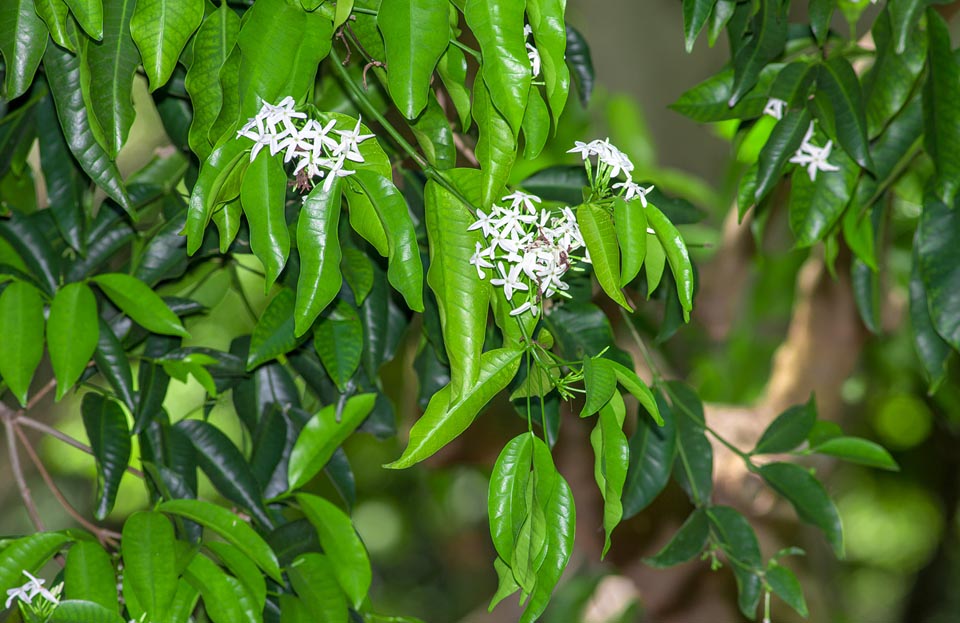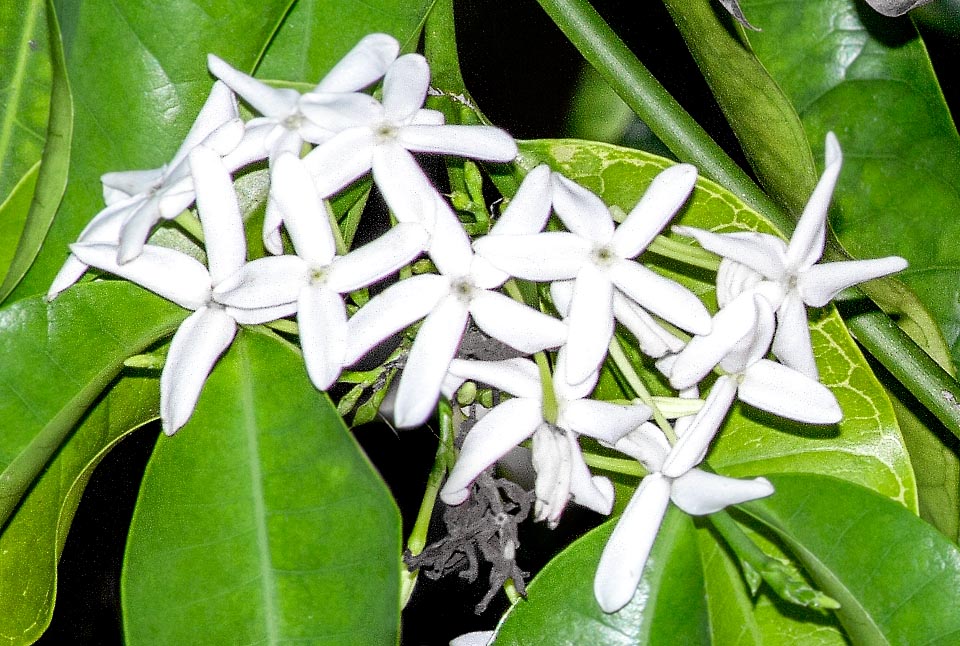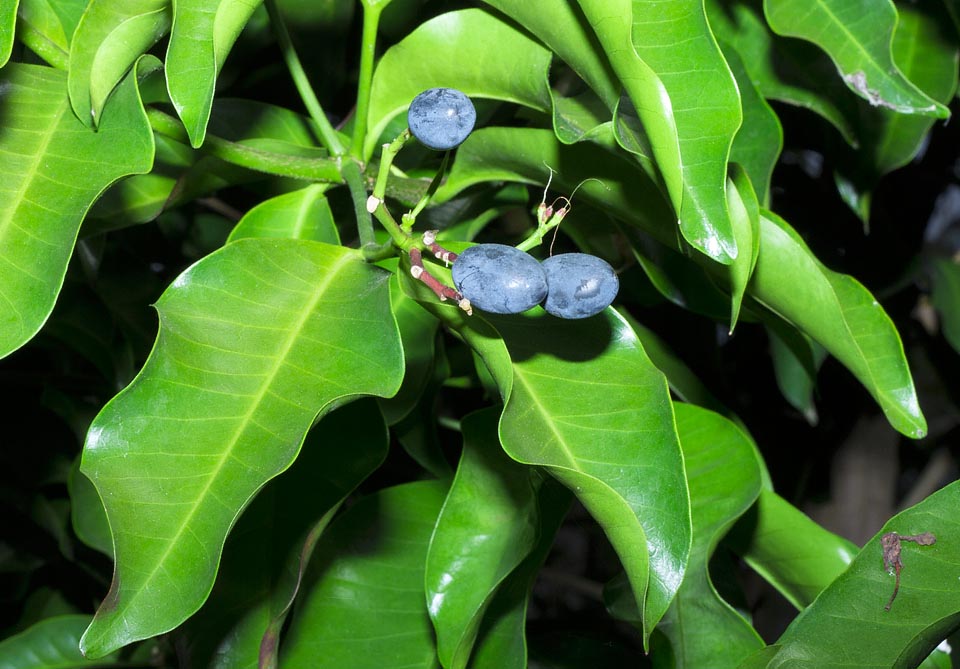Family : Apocynaceae

Text © Pietro Puccio

English translation by Mario Beltramini
The species is native to Andaman Islands, Australia (Queensland), Borneo, China (Anhui, Chongqing, Fujian, Guangdong, Guangxi, Guizhou, Hainan, Henan, Hong Kong, Hubei, Hunan, Jiangsu, Jiangxi, Kin-Men, Macao, Ma-tsu-Pai-chúan, Shanghai, Sichuan, Yunnan and Zhejiang), Java, Laos, Lesser Sunda Islands, Nicobar Islands, Peninsular Malaysia, Philippines, Singapore, Sulawesi, Sumatra, Thailand and Vietnam, where it grows in the humid forests up to about 1500 m of altitude.
The genus is dedicated to the Dutch botanist Jan Kops (1765-1849); the specific name is the Latin adjective “arboreus, a, um” = arboreal, with obvious reference.
Common names: rui mu (Chinese); anatau (Tagalog); penang sloe (Malay); ki-loentoeng, poeloet-berrit (Sundanese); ma dī khwāy, phud dong (Thai); cốp lá bắc thon, trang tây nguyên (Vietnamese).

The Kopsia arborea is an evergreen tree native to south-eastern Asia, up to beyond Australia, even 14 m tall, with compact crown and a trunk of 10-30 cm of diameter © Giuseppe Mazza
The Kopsia arborea Blume (1823) is an unarmed evergreen tree, 6-14 m tall, with compact crown and trunk, of 10-30 cm of diameter, with greyish bark tending to flake off with the age; from the wounds of all the plant exudes abundantly a white latex. The leaves, on a 0,5-1 cm long petiole, are opposite, simple, ovate to elliptic with caudate to blunt acuminate apex and slightly wavy margins, 6-25 cm long and 3-10 cm broad, coriaceous, of glossy intense green colour that turns dark red before falling.
The inflorescences, on a 1-8 cm long peduncle, are biparous terminal or lateral cymes, 5-15 cm long, carrying numerous flowers, on a 0,4 cm long pedicel, hypocrateriform (corolla with the spread margins almost perpendicular to a long thin tube), wholly white or with a very slight yellow shade at the centre.

The inflorescences, pleasantly smelling, have candid corollas with extended margins perpendicular to the long and thin central tube © Giuseppe Mazza
Calyx with 5 oblong sepals, about 0,5 cm long, corolla with corolline tube, 2-3 cm long, and 5 oblong-linear lobes 1-2 cm long and 0,4-0,6 cm broad; the flowers emit a pleasant smell. The fruits, usually solitary, are ellipsoid drupes of blackish blue colour, 1,5-3 cm long and of 1-2 cm of diameter, containing only one seed.
It propagates by seed, that does not have a long lasting germinability, in draining organic loam maintained humid at the temperature of 24-26 °C, and by cutting.
Tree with ornamental foliage and bright blooming, utilizable as isolated specimen or in rows on the sides of roads and alleys in the tropical and humid subtropical regions, its cultivation may be tried in the mildest temperate-warm regions, where temperatures around the 0 °C are short lasting exceptions.

To defend from the bite of the herbivores, all parts of the plant exude when cut an abundant white latex and are poisonous, if ingested, especially the fruits, due to the presence of strong indole alkaloids. The leaves and the fruits are locally utilized in the traditional medicine to care the inflammation of the throat and the tonsillitis © Giuseppe Mazza
It requires full sun or a slight shade and grows in various types of soil, even if poor, provided well drained, but grows best in the fertile ones, slightly acidic to neutral, maintained constantly humid; resists well to the marine aerosols, therefore can be utilized close to the sea.
All parts of the plant are poisonous if ingested, in particular the fruits due to the presence of indole alkaloids. The leaves and the fruits are utilized in the traditional medicine in the inflammations of the throat and in the tonsillitis.
Synonyms: Kopsia longiflora Merr. (1905); Kopsia scortechinii King & Gamble (1908); Kopsia laxinervia Merr. (1918); Kopsia lancibracteolata Merr. (1923); Kopsia jasminiflora Pit. (1933); Kopsia pitardii Merr. (1934); Kopsia pruniformis Rchb.f. & Zoll. ex Bakh.f (1950); Kopsia officinalis Tsiang & P.T.Li (1973).
→ To appreciate the biodiversity within the APOCYNACEAE family please click here.
